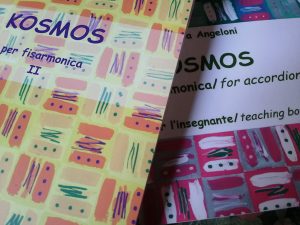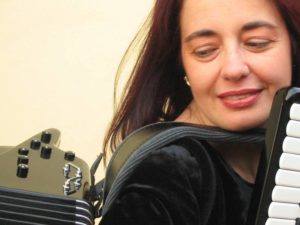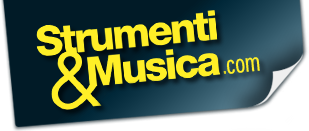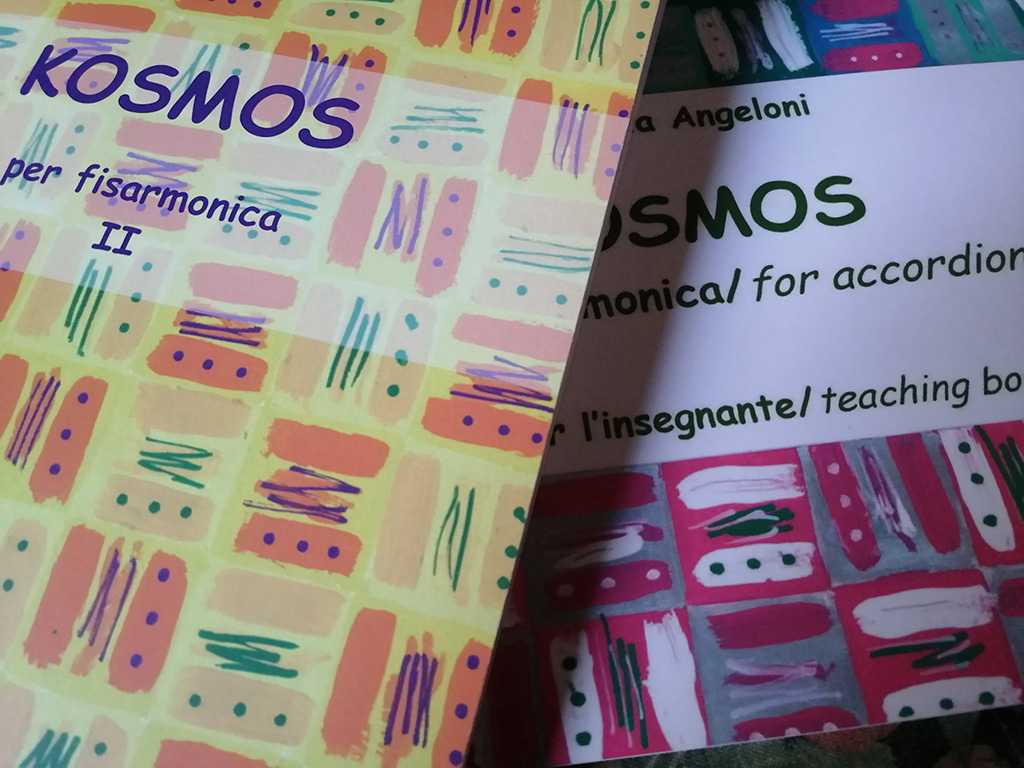Note in libertà – i “segreti” di KOSMOS II
 Kosmos II si pone come continuazione del primo volume, utilizzabile anche come primo libro dagli allievi fino a circa undici anni.
Kosmos II si pone come continuazione del primo volume, utilizzabile anche come primo libro dagli allievi fino a circa undici anni.
In apertura propone la sezione Creazioni (si veda l’articolo dedicato) e subito dopo la sezione Note in libertà: un percorso alla scoperta delle note singole e della geografia di entrambe le tastiere. Si inizia con due suoni (a cui se ne aggiungeranno altri successivamente): suoni da cantare, da ritrovare sulla tastiera e con cui improvvisare cantando e suonando. Come già si è visto, è importante che il primo contatto con il suono in tutte le sue dimensioni avvenga lontano dalla pagina scritta, attraverso attività creative che permettano di attivare la dimensione sensomotoria e una connessione diretta con espressione e comunicazione.
Vengono poi presentate brevi sequenze melodiche in una “prescrittura proporzionale” da trascrivere, dopo una prima esecuzione: così l’allievo potrà imparare a scrivere – leggere ciò che è già stato sperimentato direttamente: altezze, note, durate. Ad ogni gruppo di suoni corrisponde inoltre una serie di brevissimi studi incentrati sulle lunghe durate, per consolidare la tecnica del mantice e la interazione tra le due tastiere e allo stesso tempo sviluppare un pensiero musicale e un ascolto multidimensionale. È infatti noto come una prima formazione basata esclusivamente sulla esecuzione di una melodia (tastiera destra) accompagnata in sintesi (tastiera sinistra), crei uno sbilanciamento percettivo altamente limitante nello sviluppo della dimensione polifonica del pensiero musicale e quindi dell’ascolto e della gestione della esecuzione.
È necessario quindi che nella prima formazione entrambe le tastiere possano essere utilizzate nella produzione di sequenze melodiche (non dimentichiamo che anche la tastiera con bassi e accordi precomposti è infatti dotata di note singole!) a condizione che l’impianto fonico dello strumento risulti adeguato e funzionale. Tutte le piccole melodie di Kosmos II possono in ogni caso essere eseguite anche costruendo un accompagnamento con bassi e accordi precomposti.
La successione dei suoni è stata selezionata secondo principi precisamente individuati e basati sulle acquisizioni scientifiche concernenti l’apprendimento musicale: così sono stati scelti gli intervalli che costituiscono le prime sequenze melodiche e le loro configurazioni ritmiche, incrociandole con la modalità ottimale per la interiorizzazione della geografia delle tastiere.
 Anche qui non tutte le indicazioni esecutive sono suggerite, proprio per favorire l’indispensabile ricerca che conduce ad una integrazione autentica di tutte le funzioni. Così si chiede di sperimentare e scegliere diteggiature differenti, articolazioni (legato? staccato? detaché?), intensità, andamenti, inversioni del mantice ed eventualmente anche i registri.
Anche qui non tutte le indicazioni esecutive sono suggerite, proprio per favorire l’indispensabile ricerca che conduce ad una integrazione autentica di tutte le funzioni. Così si chiede di sperimentare e scegliere diteggiature differenti, articolazioni (legato? staccato? detaché?), intensità, andamenti, inversioni del mantice ed eventualmente anche i registri.
Come si è già visto nel precedente articolo, in Kosmos II, la sezione Per la sinistra presenta brevi sequenze ritmiche e melodiche per il consolidamento delle abilità esecutive specifiche con materiali espressamente dedicati alle caratteristiche di tastiere differenti: non solo note singole, ma anche le combinazioni di base dei bassi ed accordi precomposti. In Percorsi e Ritmi invece si lavora su orientamento, coordinazione, lettura ritmica e articolazioni.
Così il percorso è completo: i nostri suoni iniziali che avevamo conosciuto cantando, sono collocati in una geografia tattile e cinestetica, hanno un suono da ascoltare, ricordare e manipolare, diventano una piccola sequenza ritmica, una sequenza melodica, lunghe durate misurate in semibrevi e minime, disegnano percorsi tattili sulle tastiere e, nell’ultima parte del libro, danno vita alla sezione Note in viaggio: semplici brani scelti dal repertorio della tradizione europea (eseguibili a sinistra sia con note singole che con bassi e accordi precomposti), costruiti sugli intervalli sperimentati in Note in libertà.
È in preparazione, di imminente pubblicazione, il volume Kosmos, appendice al volume II, contenente una serie di accompagnamenti ai piccoli pezzi contenuti in Kosmos II. Questo accompagnamento, destinato all’insegnante o ad un allievo di livello medio – avanzato, offre la possibilità di nutrire la formazione del pensiero musicale e dell’orecchio con dei materiali armonici più ricchi e di stili differenti.
Nessuna parte di questo articolo può essere riprodotta senza il preventivo assenso dell’autrice.
Angeloni Patrizia, 2018, KOSMOS per fisarmonica. Percorsi integrati per la prima formazione. 5 voll., Youcanprint.
KOSMOS I materiali e percorsi musicali per musicisti fino a 11 anni
KOSMOS II materiali e percorsi musicali per musicisti fino a 11 anni
KOSMOS III materiali e percorsi musicali per musicisti dagli 11 anni in poi
KOSMOS IV repertorio dalla tradizione europea
KOSMOS Libro per l’insegnante.
In preparazione (Youcanprint):
KOSMOS appendice al vol. II. In duo con l’insegnante
KOSMOS appendice al vol. IV. In duo con l’insegnante
KOSMOS V a più voci. I fondamenti della polifonia
Su Amazon, Libreria Universitaria, Ibs, Feltrinelli, Mondadori
———————————————————————
 Note in libertà (Notes in freedom) – the “secrets” of KOSMOS II
Note in libertà (Notes in freedom) – the “secrets” of KOSMOS II
Kosmos II is a continuation of the first book, which can also be used as the first book by students up to about eleven years.
In the opening he proposes the Creations section (see the dedicated article) and immediately after the Note in Libertà (Notes in freedom) section: a journey to discover the single notes and the geography of both keyboards. It starts with two sounds (other sounds will be added in the following pages): notes to be found on the keyboard, to sing and on wich to improvise and play. As we have already seen, it is important that the first contact with sound in all its dimensions is made far from the written page, through creative activities that allow to activate the sensomotor dimension and a direct connection with expression and communication.
They then present short melodic sequences in a “proportional pre – writing” to be transcribed, after a first performance: so the student can learn to write – read what it has already been directly experienced: sound pitches, notes, sound duration. Each group of sounds also corresponds to a series of very short studies focused on the long duration, to consolidate the bellows technique and the interaction between the two keyboards; at the same time is possible to develop a musical thought and a multidimensional listening.
It is in fact known as a first training based exclusively on the execution of a melody (right keyboard) accompanied in synthesis (left keyboard) create a highly limiting perceptual imbalance in the development of the polyphonic dimension of musical thought and therefore of listening and performing management.
It is therefore necessary that in the first musical – instrumental training both keyboards can be used in the production of melodic sequences (do not forget that even the keyboard with bass and precomposed chords is in fact equipped with single notes!) provided that the sound system of the instrument is adequate and functional. All the small melodies of Kosmos II can in any case be performed also building an accompaniment with bass and pre-set chords. The sequence of sounds has been selected according to precisely identified principles and based on scientific knowledge concerning musical learning: thus have been chosen the intervals that make up the first melodic sequences and their rhythmic configurations, crossing them with the optimal way to internalize the geography of keyboards.
 Here too, not all the executive indications are suggested, precisely to encourage the indispensable research that leads to an authentic integration of all functions. So the study plan asks to experiment and choose different fingering, articulations (legato? staccato? detaché?), intensity, speed, bellows directions and possibly also the registers.
Here too, not all the executive indications are suggested, precisely to encourage the indispensable research that leads to an authentic integration of all functions. So the study plan asks to experiment and choose different fingering, articulations (legato? staccato? detaché?), intensity, speed, bellows directions and possibly also the registers.
As already seen in the previous article, in Kosmos II, the section named Per la sinistra (For the left) presents short rhythmic and melodic sequences for the consolidation of specific executive skills with materials expressly dedicated to the characteristics of different keyboards: not only single notes but also basic combinations of bass and precomposed chords. In Percorsi e Ritmi (Paths and Rhythms) we work on orientation, coordination, rhythmic reading and articulations.
So the path is complete: our initial sounds that we had known singing, are placed in a tactile and kinesthetic geography, have a sound to listen, remember and manipulate, they become a small rhythmic sequence, a melodic sequence, long durations measured in semi-short and minimum; they draw tactile paths on keyboards and, in the last part of the book, give life to the section Note in viaggio (Notes en voyage): simple pieces chosen from the repertoire of the European tradition (addressed to the left keyboard with both single notes and bass and precomposed chords), built on the intervals tested in Note in Libertà (Notes in freedom).
In preparation, soon to be published, Kosmos, appendix to book II, containing a series of accompaniments to the small pieces contained in Kosmos II. This accompaniment, intended for the teacher or for an advanced – middle level student, offers the possibility to nourish the formation of the musical thought and the ear with richer harmonic materials and different styles.
No part of this article may be reproduced without the prior consent of the author.
The collection:
Angeloni Patrizia, 2018, KOSMOS per fisarmonica. Percorsi integrati per la prima formazione. 5 voll., Youcanprint. (KOSMOS For accordion. Integrated instrumental training):
KOSMOS I musical material and training plan for musicians up to 11 years old
KOSMOS II musical material and training plan for musicians up to 11 years old
KOSMOS III musical material and training plan for musicians from 11 years old onwards (English/italian text)
KOSMOS IV traditional european repertoire
KOSMOS teaching book (English/italian text. English text also for Kosmos I , II)
In preparation, soon to be published (by Youcanprint):
KOSMOS appendix to book II, in duo with your teacher
KOSMOS appendix to book IV, in duo with your teacher
KOSMOS V a più voci. Polyphony basics
On-line stores: Amazon, Libreria Universitaria, Ibs, Feltrinelli, Mondadori, Youcanprint

